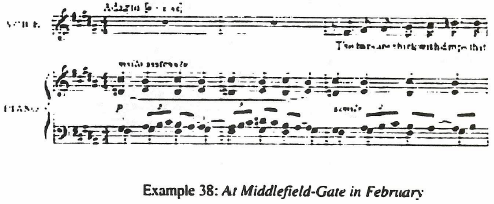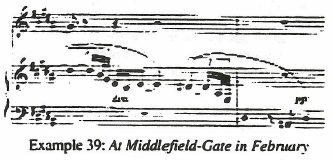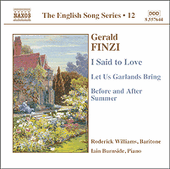At Middle-Field Gate in February
Poet: Thomas Hardy
Date of poem:
Publication date:
Publisher:
Collection:
History of Poem:
Poem
At Middle-Field Gate in February |
||
|---|---|---|
| 1 | The bars are thick with drops that show | |
| 2 | As they gather themselves from the fog | |
| 3 | Life silver buttons ranged in a row, | |
| 4 | And as evenly spaced as if measured, although | |
| 5 | They fall at the feeblest jog. | |
| 6 | They load the leafless hedge hard by, | |
| 7 | And the blades of last year's grass, | |
| 8 | While the fallow phoughland turned up nigh | |
| 9 | In raw rolls, clammy and clogging lie - | |
| 10 | Too clogging for feet to pass. | |
| 11 | How dry it was on a far-back day | |
| 12 | When straws hung the hedge and around, | |
| 13 | When amid the sheaves in amorous play | |
| 14 | In curtained bonnets and light array | |
| 15 | Bloomed a bevy now underground! | |
(Hardy, 480) |
||
Content/Meaning of the Poem:
Speaker:
Setting:
Purpose:
Idea or theme:
Style:
Form:
Synthesis:
Published comments about the poem:
✦✼✦✼✦✼✦✼✦✼✦✼✦✼✦✼✦✼✦✼✦✼✦✼✦✼✦✼✦✼✦✼✦✼✦
✦✼✦✼✦✼✦✼✦✼✦✼✦✼✦✼✦✼✦✼✦✼✦✼✦✼✦✼✦✼✦✼✦✼✦
Musical Analysis
Composition date:
Publication date:
Publisher: Boosey & Hawkes - Distributed by Hal Leonard Corporation
Tonality:
Transposition:
Duration:
Meter:
Tempo:
Form:
Rhythm:
Melody:
Texture:
Vocal Range:
Tessitura:
Dynamic Range:
Accompaniment:
Published comments about the music:
Pedagogical Considerations for Voice Students and Instructors:
✦✼✦✼✦✼✦✼✦✼✦✼✦✼✦✼✦✼✦✼✦✼✦✼✦✼✦✼✦✼✦✼✦✼✦
✦✼✦✼✦✼✦✼✦✼✦✼✦✼✦✼✦✼✦✼✦✼✦✼✦✼✦✼✦✼✦✼✦✼✦
| Pitch Analysis | ||||||
|---|---|---|---|---|---|---|
| pitch | stanza 1 |
stanza 2 |
stanza 3 |
stanza 4 |
total | |
highest |
A |
|||||
G |
||||||
F |
||||||
E |
||||||
D |
||||||
middle C |
||||||
B |
||||||
A |
||||||
G |
||||||
F |
||||||
lowest |
E |
|||||
| Rhythm Duration Analysis of Vocal Line | |||||
|---|---|---|---|---|---|
| stanza 1 | stanza 2 | stanza 3 | stanza 4 | total | |
16th note |
|||||
8th note |
|||||
dotted 8th |
|||||
quarter note |
|||||
dotted quarter |
|||||
triplet |
|||||
half note |
|||||
dotted half |
|||||
stanza total |
|||||
✦✼✦✼✦✼✦✼✦✼✦✼✦✼✦✼✦✼✦✼✦✼✦✼✦✼✦✼✦✼✦✼✦✼✦
Audio Recordings
The Songs of Gerald Finzi to Words by Thomas Hardy
|
|
|
|
Gerald Finzi |
|
|
|
The English Song Series - 12 |
|
|
|
✦✼✦✼✦✼✦✼✦✼✦✼✦✼✦✼✦✼✦✼✦✼✦✼✦✼✦✼✦✼✦✼✦✼✦
The following is an analysis of **** by Gerhardus Daniël Van der Watt. Dr. Van der Watt extended permission to post this excerpt from his dissertation on October 8th, 2010. His dissertation dated November 1996, is entitled:
The Songs of Gerald Finzi (1901-1956) To Poems by Thomas Hardy
This excerpt comes from Volume II and begins on page *** and concludes on page ***. To view the methodology used within Dr. Van der Watt's dissertation please refer to: Methodology - Van der Watt.
1. Poet
Specific background concerning poem:
2. Poem
Setting
1. Timbre
VOICE TYPE/RANGE
2. Duration
METRE
Rhythmic motifs
Rhythmic activity vs. Rhythmic stagnation
Rhythmically perceptive, erroneous and interesting settings
Lengthening of voiced consonants
3. Pitch
Intervals: Distance distribution
Interval |
Upwards |
Downwards |
Unison |
||
Second |
||
Third |
||
Fourth |
||
Fifth |
||
Sixth |
||
Seventh |
Interval |
Bar no. |
Word/s |
Reason/s |
Melodic curve
Climaxes
System no. |
Pitch |
Word |
Phrase lengths
System no. |
From - To |
Suggested reason/s |
Chromaticism
HARMONY AND COUNTERPOINT
Non-harmonic tones
Harmonic devices
Counterpoint
FREQUENCY
RANGE
VARIETY
DYNAMIC ACCENTS
No. of parts |
No. of beats |
Percentage |
2 parts |
||
3 parts |
||
4 parts |
||
5 parts |
||
6 parts |
7. Mood and atmosphere
General comment on style
The following is an analysis of At Middle-Field Gate in February by Curtis Alan Scheib. Dr. Scheib extended permission to post this excerpt from his dissertation on February 17th, 2012. His dissertation dated 1999, is entitled:
Gerald Finzi's Songs For Baritone On Texts By Thomas Hardy: An Historical And Literary Analysis And Its Effect On Their Interpretation
This excerpt begins on page seventy-one and concludes on page seventy-three.
At Middle-Field Gate in February |
||
|---|---|---|
| The bars are thick with drops that show | ||
| As they gather themselves from the fog | ||
| Life silver buttons ranged in a row, | ||
| And as evenly spaced as if measured, although | ||
| They fall at the feeblest jog. | ||
| They load the leafless hedge hard by, | ||
| And the blades of last year's grass, | ||
| While the fallow phoughland turned up nigh | ||
| In raw rolls, clammy and clogging lie - | ||
| Too clogging for feet to pass. | ||
| How dry it was on a far-back day | ||
| When straws hung the hedge and around, | ||
| When amid the sheaves in amorous play | ||
| In curtained bonnets and light array | ||
| Bloomed a bevy now underground! | ||
(Hardy, 480) |
||
The poet paints a bleak picture of February, contrasting it with the dry warmth of an earlier time before his love, then blooming, descended to her grave. Finzi completed the song in 1956, though apparently he had begun to work on it many years earlier and had left it unfinished. Joy Finzi noted in her journal entry of 21 February 1956 that he had intended it to be for tenor, but in the final writing of it, the song turned, "in the final making, into an inevitable baritone." (Banfield, 299) Finzi begins with an ostinato figure, seen in example 38, whose shape and harmony are meant to convey the bleakness of the scene.

Finzi continues the pictorial effect at the fall of the droplets off the gate by using an irregular falling figure in the right hand of the piano, falling off the level of the ostinato (example 39).

The second verse resumes the ostinato, this time up a half-step as the bleakness of the scene intensifies. The third line in the second verse of the poem contains a revision by Hardy from his original. Finzi set both lines, giving the original as an alternate. A note in the score indicates that Finzi preferred Hardy's revision, in spite of the grammatical slip of leaving the original verb "lie" to agree with the new noun "plounghland." The third verse leaves the cold ostinato, both voice and piano finding a lower and warmer tessitura for the remembrance of the "far-back day." As usual, the piano has the last word, repeating the falling figure from the opening of the third verse, this time reinforcing that the lost love is underground.
The preceding was an analysis of At Middle-Field Gate in February by Curtis Alan Scheib. Dr. Scheib extended permission to post this excerpt from his dissertation on February 17th, 2012. His dissertation dated 1999, is entitled:
Gerald Finzi's Songs For Baritone On Texts By Thomas Hardy: An Historical And Literary Analysis And Its Effect On Their Interpretation
The excerpt began on page seventy-one and concluded on page seventy-three.



